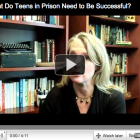
Some of you may have heard this disturbing account of a drug court in Glynn County, Georiga, aired recently on "This American Life." Usually, a drug court may take a year, possible two years, to complete. For 24-year-old Lindsey Dills, who was 18 when she entered the Glynn County juvenile drug court, she won't be done with it until 10-1/2 years later, counting time behind bars and probation. Now, the show makes it clear that this particular Georgia drug court is commonly thought to be run counter to generally-accepted principles of drug court. But I thought it would be a good time to mention the so-called : "16 strategies" for juvenile drug courts. (Follow the link for a monograph from the Department of Justice, explaining the details.)
Here they are:
Strategy 1: Collaborative Planning
Strategy 2: Teamwork
Strategy 3: Clearly Defined Target Population and Eligibility Criteria
Strategy 4: Judicial Involvement and Supervision
Strategy 5: Monitoring and Evaluation
Strategy 6: Community Partnerships
Strategy 7: Comprehensive Treatment Planning
Strategy 8: Developmentally Appropriate Services
Strategy 9: Gender-Appropriate Services
Strategy 10: Cultural Competence
Strategy 11: Focus on Strengths
Strategy 12: Family Engagement Strategy 13: Educational Linkages
Strategy 14: Drug Testing
Strategy 15: Goal-Oriented Incentives and Sanctions
Strategy 16: Confidentiality
The above story is reprinted with permission from Reclaiming Futures, a national initiative working to improve alcohol and drug treatment outcomes for youth in the juvenile justice system.



